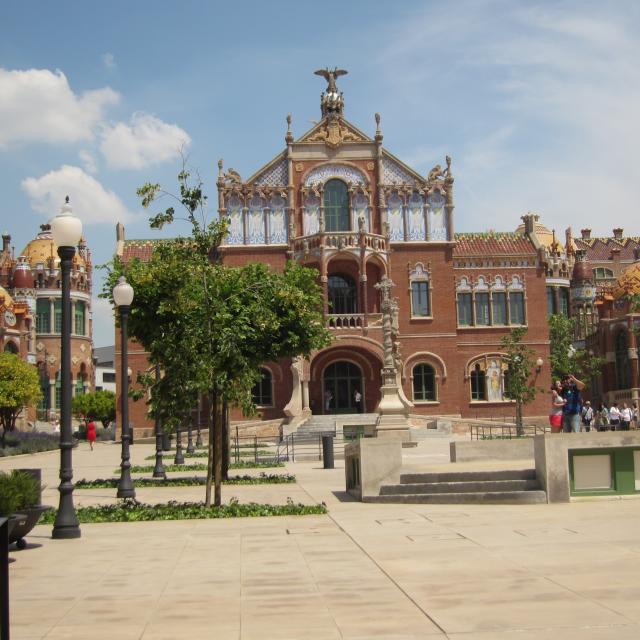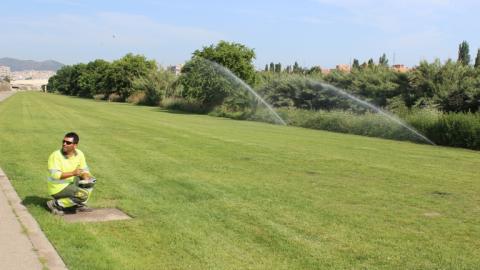Built between 1902 and 1930 and an important architectural expression of Catalan modernism, the hospital of the Holy Cross and Saint Paul is a city within a city. This modernist ensemble was listed by UNESCO as a world heritage site in 1997. The building was inaugurated at the end of February 2014, after four years of restoration work. Out of the twelve pavilions that make up the complex, ten have been completed and there is ongoing building work on the other two. International institutions such as the World Health Organisation, Asia House and even the United Nations University occupy the renovated pavilions. Each pavilion has two gardens, which are also in the process of renovation.

These gardens have grass lawns and are planted with date palms, orange trees, laurels, lavender and other Mediterranean species… A custom-designed irrigation system, allowing for the water requirements of each plant to be met, is being progressively installed. Accompanied by Manuel Marti and Imma Pedemonte from the company Hunter, we arrived at the Hospital of Saint Paul via the Avenida de Gaudi, where we were able to see the Basilica of the Holy Family at the other end, as these two modernist style buildings face each other.
The Administration pavilion, the main building of the complex, which we could see when we arrived, impressed us with the intricacies of its ornamental patterns. It has been designed as a monumental altarpiece with its layout directly related to the spiritual world: a central main part with two lateral bodies spreading outwards, giving the impression of a “gigantic supreme being” welcoming the visitor with open arms. The facades are decorated with large mosaic murals representing various historical personages and patron saints of the city of Barcelona. Built between 1905 and 1910, it was designed as the main entrance, to be used for general administration and hospital admissions. The hospital complex consists of a total of twelve pavilions built symmetrically around two axes, one vertical, the other horizontal, and was designed by the architect Luis Domènech i Montaner.
We walked alongside the building and entered by a second entrance where we were met by Santiago Andes from the company Connatura. Connatura is responsible for renovating all the gardens. We then headed towards the San Manuel Pavilion, the former male infirmary building. They have just finished restoring the gardens in front of the pavilion.
Strips of Zoysia Japonica lawn grass, a very dense and hardy variety of turf, are laid in the spaces between the paving stones and provide attractive areas of greenery, while still allowing people to walk around the gardens.
"These strips of lawn are watered by a subsurface 16 mm PLD-ESD drip irrigation system with a fibre fleece mat".
“This irrigation method encourages the capillary rise of the water,” explains Manuel Marti from the company Hunter. In total two kilometres of 16 mm PLD-ESD will have been installed over the whole site once the work has been completed.
Nearby, flower beds planted with laurel, lavender, rosemary, verbena lemongrass and other medicinal plants, in keeping with the theme of healing the sick, blend in perfectly with the surrounding buildings. These flowerbeds are irrigated with a traditional subsurface drip system. Finally, areas of lawn, watered with MP Rotator sprinklers, add a touch of freshness to the whole area. So we have small areas of greenery, very well looked after, and irrigated with a drip system or low flow sprinklers, allowing for a considerable reduction to be made in water consumption (8 m3 per year). All of the pavillion gardens will eventually have an irrigation system. A new area of greenery is added every four months.
The architect incorporated nature into his design from the very beginning, planning for two gardens for each pavilion, these being planted during the first construction phase (1909 – 1914). The architect’s aim was to provide a cheerful, optimistic aspect, soothing the distress of patients and helping them to get better. From this perspective, the garden vegetation is not only for decorative purposes, the plants and trees also purify the air and absorb bacteria and dust particles as well as toxic gases. The vegetation also has an influence on the climate, protecting the area from wind, conserving moisture and preventing desiccation.
We then went along to the underground room located next to the pavilion, which houses the building’s geothermal system, air conditioning and ACC99D decoder irrigation controller, all operating via Ethernet. “At present, we have four irrigation programmes: one for the Zoïsia Japonica, one for the flowerbeds, another one for the lawns and a fourth for the new plants”, explained Imma from the company Hunter.
"The installation at present comprises 13 or 14 stations, but it will eventually have 54 with the use of the decoder system".
The programmer is linked to the Hunter IMMS central control system, located in an office a short distance away. Irrigation can be activated via an ordinary mobile phone. “We have opted for a decoder system because it allows the installation to be carried out progressively, in stages”, explains Santiago Andes from the company Connatura. In fact, the modules allow for further stations to be added and extended to the IMMS software at the same time. The IMMS central control system allows for the input of extremely precise programmes, adapted to different zones (areas of shade between buildings…), different types of vegetation (lawns, shrubs, Zoïsia Japonica…) and different irrigation systems (MP Rotator, drip irrigation, PLD…).
We then headed towards the central promenade, where in the past horse chestnuts, lime trees and orange trees were planted, as well as deciduous trees which provided warmth in the winter and shade in the summer. A few of those original trees still remain, such as the two date palms, which dominate the borders at the entrance or the orange trees. It is on this avenue that the surgeons’ pavilion is situated, a little modernist gem at the centre of the complex, with large windows facing northwards, thus allowing more light for the surgeon. Underground walk ways protecting patients from the weather interlink the pavilions. Underneath each pavilion, there is also a tank for storing the water pumped up from the aquifer. And this non-potable filtered water is used to irrigate the green areas of the complex.
The gardens of the hospital of Saint Paul provide an excellent example of a custom-designed, water saving irrigation system, adapted to meet the water requirements of very sophisticated gardens.

